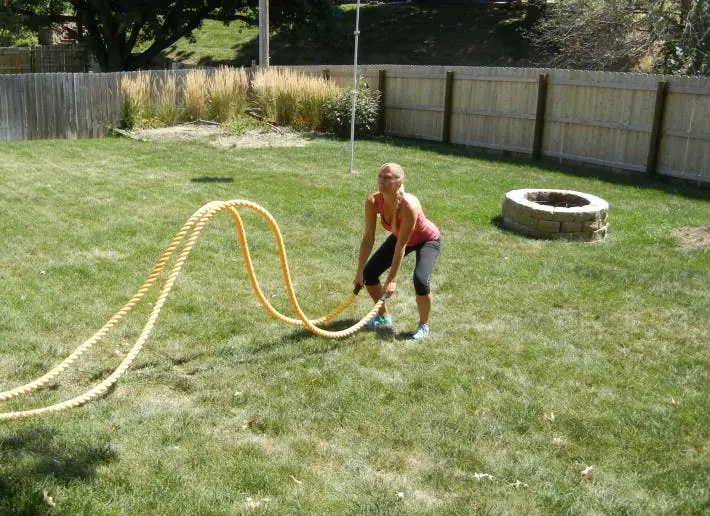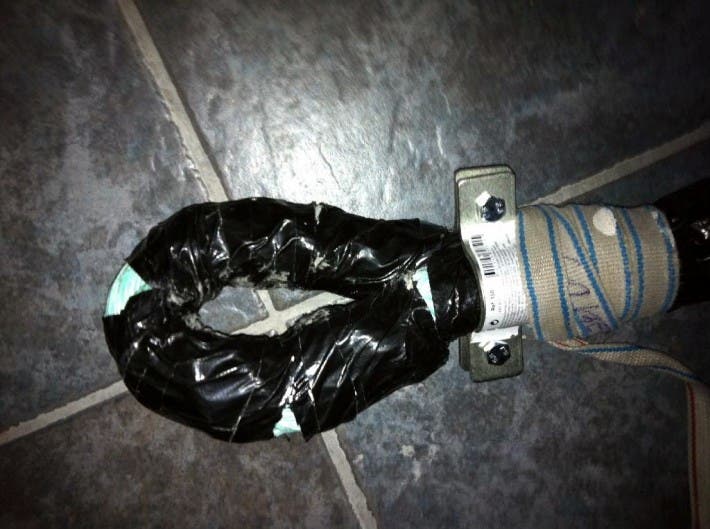Training with a large diameter rope (normally they are marketed with a diameter of 38 mm) is very useful for working both on cardiovascular endurance and muscular strength-endurance , among other physical capacities. But its use does not stop there; we can enhance our grip like no other tool by climbing the rope. For example, the qualitative jump in terms of the difficulty of the exercise in a conventional chin-up, or in a chin-up grabbing a rope, is quite high.

What type of rope do I need?
High tenacity nylon cords, 38 mm in diameter, are normally used. These ropes are braided, very resistant to traction, abrasion and humidity. It is marketed in lengths of 9, 12, 15 meters , the latter being the most widely used. I advise a minimum of 12 meters in length if we want to carry out battle rope work (we will comment on what it consists of later).
Important details when buying a rope
Apart from the type of rope (we have commented that the best are the nylon ones because they guarantee us a very high resistance, as well as a comfortable and safe grip), it is very important that it has the ends with a heat-sealed finish. If it did not have this finish, we would have to give it to them in the following way: burn the ends of the rope, and protect it with duct tape so that the rope does not fray at its ends if it does not have a closure. Normally they are braided, and they have thin ropes as guides that pass through them, and once they are released, we will no longer be able to braid them manually with the same starting pressure. In the next photo we see an example of a rope frayed at its ends.

It is also important that one of the ends has an eye- type finish to tie knots with the rope easily and safely. Otherwise, we can use metal clamps that we can find in industrial hardware stores to make the eyelet afterwards.

This closure is important, if we want to hang it from a tree branch safely, or from a beam to climb the rope, or to carry heavy objects. Otherwise, the rope does not need maintenance, and if we take good care of it, it will last us a lifetime.
What exercises can I do with a rope?
Next we are going to mention the most important ones, but many more can be done. Our imagination is the limit.
Battle rope
Perhaps this is its most used application in recent times. It is a very demanding exercise, both at a cardiovascular level and in terms of muscular endurance. 10 minutes of waves of all kinds are a guarantee for a good sweat, with congestion of the arms and forearms included, due to the diameter of the rope, which makes our grip work without rest, and the continuous elbow flexions, which request the biceps. It is an exercise that works many muscle groups, not just the arms. The shoulders also do work, as do the core stabilizers to keep our torso upright, compensating for the load in front of us, and that we are continually moving. As the rope is raised, the resistance to overcome will be greater and greater, and due to the undulatory movement of the rope, variations in the direction of the resistance will occur. All this will give us a dynamic work with a very demanding load. In addition, intermuscular coordination is required throughout the body (the biceps and triceps are coordinated in their concentric and eccentric contractions to cause the continuous movement of the rope in the form of waves) and the stabilizing muscles of the core also work. The battle rope devours calories . It is one of the best HIIT you can find. It can also be done outdoors. In the following video we can see the most characteristic exercise of the battle rope. The combinations that we can make in the selection of exercises, and activity / rest times are endless. Although we cannot forget that the goal when doing battle rope work is to move the rope fast to increase the production of force and speed.
To perform battle rope, all we need is a fixed point (a post for example), where to anchor the rope so that the waves that we generate when applying shocks to the rope, move without rest through it. As a summary, we are going to list the multiple advantages of this type of training.
Advantages provided by the battle rope
- Work cardiovascular resistance, and muscular strength-resistance in the same session. It is possible to burn a large amount of calories, if we are able to maintain a medium-high intensity during the execution of the rope exercises.
- As we have mentioned, with 10 minutes of work you can obtain great benefits. In addition, we always work several muscles at the same time.
- We can train outdoors and anywhere, as it can be comfortably carried in a bag.
- It allows variability of exercises (vertical, horizontal waves, jump waves, stride, etc.).
- Its impact on lower body joints is zero. Many people who have ankle, knee or back problems, and want to seek fat-burning workouts, cannot go for a run due to the impact it has on their aching joints. The “battle rope” is your solution.
- I work with multiple muscle groups at the same time, also involving great coordination between them.
Rope pull
To work the pull patterns, while our core participates in stabilizing our body. We can do it lying face down, kneeling, standing, dragging heavy objects. In addition, we can control the speed of execution, making the most explosive jerks possible. Another additional advantage, with respect to a work with loads such as Pendlay or dominated rowing for example, is that we work in a concentric phase throughout the exercise, which will allow us to put more work volume into our workouts. The grip will be in high demand as well. The exercise in the video consists of pulling the loaded sled towards us, and then pushing it as fast as we can. Excellent finisher for a training session.
We can perform dragging without using the strength of the arms, using our lower body. The exercise shown in the following video, the heavy reverse sled drag , is a great exercise for the quadriceps, especially if we adjust the duration of the exercise to 30 ″ -45 ″ (range of time under tension or TUT ideal for hypertrophy), since we will brutally congest our quadriceps. For this we would need a track about 10-2o meters away. And all this with the added benefit that our spine does not have to bear a load like a squat or a barbell lunge. Obviously the load dragged by the sled must be very heavy. The greater the length of rope between us and the sled, the easier it will be to perform the exercise. For this reason, it is convenient to adjust the measurement of it well as in the video (in the video, use a belt with a strap or sling, but the exercise is the same as with a rope).
Climb the rope
An exercise hated by many, but effective as few. Your lats and arm flexors will primarily do a tough job, in addition to building a bomb-proof grip. Climbing the rope is an exercise for advanced, but we can follow a progression starting from scratch practically.
Level 0
In a standing position (standing), we stand in front of the rope. We grab it with both hands, and begin to descend on the rope until we reach a deep squat position. We climb again with only our arms on the rope while we are extending our knees and hips until we reach a standing position. At no time did we lift our feet off the ground.
Level 1
In the next step, we increase the range of travel of the movement. The starting position is the same as in the previous level, but in this case we will descend on the rope until reaching a practically supine position with the heels resting on the ground, without releasing the rope. From there we go back up on the rope. In minute 3 of the following video, we see an example of the exercise in question.
Level 2
At this level we already climb with our whole body on the rope, using our legs and taking our feet off the ground. To do this we will try to wind and bend the rope at the feet with the legs bent. The extension of the legs will help the climb with the arms to be able to climb with the rope. This maneuver that we carry out with our feet allows us to create a “semi-fixed” point on the rope, on which to push and be able to climb the rope. In minute 1 we see the detail of the hitch of the leg to the foot.
Level 3
Now we are trying to climb the rope without hugging the leg with our feet. The feet will also climb on the rope, taking advantage of the extension force of our legs.
Level 4
In this level we only use the legs by swinging them, but without climbing with them on the rope.
Level 5
We climb the rope from a sitting position. At minute 3.40 ″ of the following video you can see an example. It is always important to help the swinging of the legs to achieve greater momentum when climbing the rope.